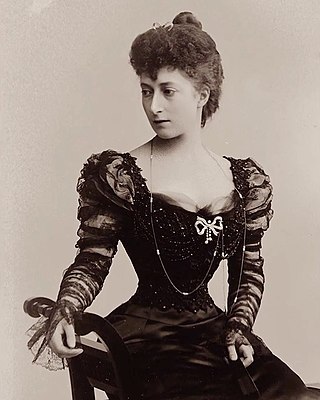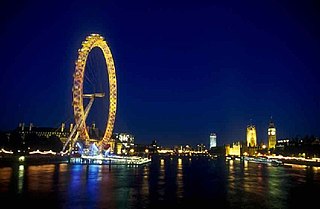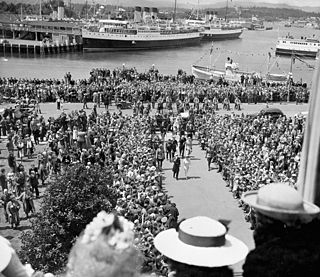
Mary of Teck was Queen of the United Kingdom and the British Dominions, and Empress of India, from 6 May 1910 until 20 January 1936 as the wife of King-Emperor George V.

Ian Rank-Broadley FRBS is a British sculptor who has produced many acclaimed works, among which are several designs for British coinage and the memorial statue of Princess Diana at Kensington Palace in London unveiled on her 60th birthday in 2021.

Kensington Gardens, once the private gardens of Kensington Palace, are among the Royal Parks of London. The gardens are shared by the City of Westminster and the Royal Borough of Kensington and Chelsea and sit immediately to the west of Hyde Park, in western central London. The gardens cover an area of 107 hectares. The open spaces of Kensington Gardens, Hyde Park, Green Park, and St. James's Park together form an almost continuous "green lung" in the heart of London. Kensington Gardens are Grade I listed on the Register of Historic Parks and Gardens.

Lady Victoria Patricia Helena Elizabeth Ramsay was a granddaughter of Queen Victoria. Upon her marriage to Alexander Ramsay, she relinquished her title of a British princess and the style of Royal Highness.

Princess Louise, Duchess of Argyll, was the sixth child and fourth daughter of Queen Victoria and Prince Albert.

Princess Augusta of Cambridge was a member of the British royal family, a granddaughter of George III. She married into the Grand Ducal House of Mecklenburg-Strelitz and became the Grand Duchess of Mecklenburg-Strelitz.

Princess Marie Louise of Schleswig-Holstein was a granddaughter of Queen Victoria.

Maud of Wales was the Queen of Norway as the wife of King Haakon VII. The youngest daughter of King Edward VII and Queen Alexandra of the United Kingdom, she was known as Princess Maud of Wales before her marriage, as her father was the Prince of Wales at the time.

Kensington Palace is a royal residence set in Kensington Gardens, in the Royal Borough of Kensington and Chelsea in London, England. It has been a residence of the British royal family since the 17th century, and is currently the official London residence of the Prince and Princess of Wales, the Duke and Duchess of Gloucester, the Duke and Duchess of Kent, and Prince and Princess Michael of Kent.
Lord Frederick Michael George David Louis Windsor is a British financial analyst, and the only son of Prince and Princess Michael of Kent. He is married to British actress Sophie Winkleman. He is currently 52nd in the line of succession to the British throne. He is president of Soldier On!, a charity for the professional development of vulnerable and disadvantaged people.

The Golden Jubilee of Elizabeth II was the international celebration held in 2002 marking the 50th anniversary of the accession of Queen Elizabeth II on 6 February 1952. It was intended by the Queen to be both a commemoration of her 50 years as monarch and an opportunity for her to officially and personally thank her people for their loyalty.

The history of monarchy in Canada stretches from pre-colonial times through to the present day. Canada's monarchical status began with the establishment of the French colony of New France in the name of King Francis I in 1534; although a previous claim was made by England in the name of King Henry VII in 1497 when John Cabot made landfall in what is thought to be modern day Newfoundland or Nova Scotia. Through both these lineages, the present Canadian monarchy can trace itself back to the Anglo-Saxon period and ultimately to the kings of the Angles and the early Scottish kings. Kings and queens reigning over Canada have included the monarchs of France, those of the United Kingdom, and those of Canada. Canadian historian Father Jacques Monet said of Canada's Crown: "[it is] one of an approximate half-dozen that have survived through uninterrupted inheritance from beginnings that are older than our Canadian institution itself."

Queen Elizabeth II owned a historic collection of jewels – some as monarch and others as a private individual. They are separate from the gems and jewels of the Royal Collection, and from the coronation and state regalia that make up the Crown Jewels.

The Golden Jubilee of Queen Victoria was celebrated on 20 and 21 June 1887 to mark the 50th anniversary of Queen Victoria's accession on 20 June 1837. It was celebrated with a Thanksgiving Service at Westminster Abbey, and a banquet to which 50 European kings and princes were invited.

Royal tours of Canada by the Canadian royal family have been taking place since 1786, and continue into the 21st century, either as an official tour, a working tour, a vacation, or a period of military service by a member of the royal family. Originally, official tours were events predominantly for Canadians to see and possibly meet members of their Canadian royal family, with the associated patriotic pomp and spectacle. However, nearing the end of the 20th century, such occasions took on the added dimension of a theme; for instance, the 2005 tour of Saskatchewan and Alberta by Queen Elizabeth II and Prince Philip, Duke of Edinburgh, was deemed to be a vehicle for the Queen and Canadians to honour "The Spirit of Nation Builders." The couple's tour in 2010 was themed "Honouring the Canadian Record of Service— Past, Present and Future." Official royal tours have always been vested with civic importance, providing a regionalised country with a common thread of loyalty.

From an early age, Queen Elizabeth II took a keen interest in horses. Into her reign, this developed into one of her main leisure time activities with a particular emphasis on the breeding of thoroughbreds for horse racing.

Francis John Williamson was a British portrait sculptor, reputed to have been Queen Victoria's favourite.

The Ruby Jubilee of Elizabeth II in 1992 marked the 40th anniversary of the accession of Queen Elizabeth II on 6 February 1952. Contrary to her Silver Jubilee in 1977, there were no widespread public celebrations of the Ruby Jubilee; it was a low-profile event. However, there were some observances to mark the milestone.

The Platinum Jubilee of Elizabeth II was the international celebration in 2022 marking the 70th anniversary of the accession of Queen Elizabeth II on 6 February 1952, the first British monarch to ever celebrate one.




















